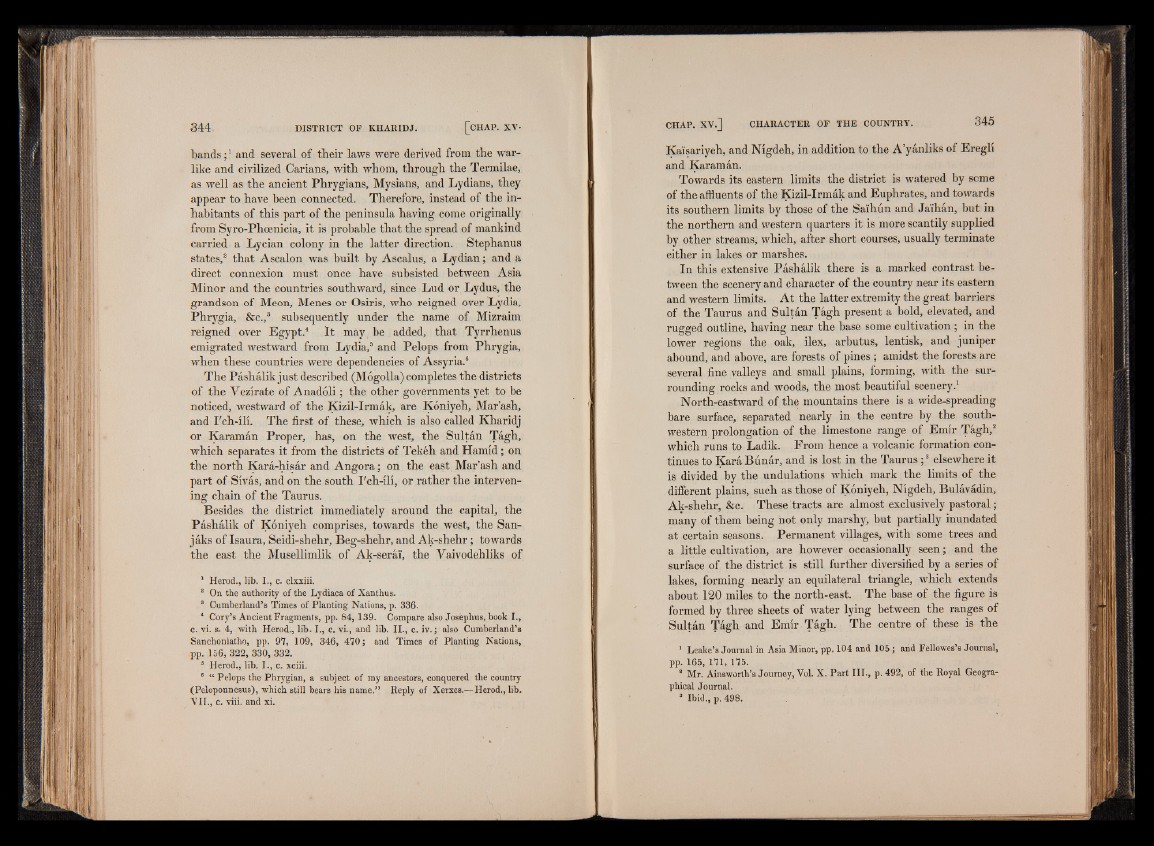
bands;1 and several of their laws were derived from the warlike
and civilized Carians, with whom, through the Termilae,
as well as the ancient Phrygians, Mysians, and Lydians, they
appear to have been connected. Therefore, instead of the inhabitants
of this part of the peninsula having come originally
from Syro-Phcenicia, it is probable that the spread of mankind
carried a Lycian colony in the latter direction. Stephanus
states,2 that Ascalon was built by Ascalus, a Lydian; and a
direct connexion must once have subsisted between Asia
Minor and the countries southward, since Lud or Lydus, the
grandson of Meon, Menes or Osiris, who reigned over Lydia,
Phrygia, &c.,3 subsequently under the name of Mizraim
reigned over Egypt.4 It may be added, that Tyrrhenus
emigrated westward from Lydia,5 and Pelops from Phrygia,
when these countries were dependencies of Assyria.6
The Páshálik just described (Mogolla) completes the districts
of the Vezirate of Anadóli; the other governments yet to be
noticed, westward of the Kizil-Irmák, are Koniyeh, Mar’ash,
and I'ch-ill. The first of these, which is also called Kharidj
or Karamán Proper, has, on the west, the Sultán Tágh,
which separates it from the districts of Tekéh and Hamid; on
the north Kará-hisár and Angora; on the east Mar’ash and
part of Sívás, and on the south Pch-ili, or rather the intervening
chain of the Taurus.
Besides the district immediately around the capital, the
Páshálik of Kóniyeh comprises, towards the west, the San-,
jáks of Isaura, Seidi-shehr, Beg-shehr, and Ak-shehr; towards
the east the Musellimlik of Ak-serai, the Yaivodehliks of
1 Herod., lib. I., c. clxxiii.
8 On the authority of the Lydiaca of Xanthus.
8 Cumberland’s Times of Planting Nations, p. 336.
4 Cory’s Ancient Fragments, pp. 84, 139. Compare also Josephus, book I.,
c. vi. s. 4, with Herod., lib. I., c. vi., and lib. II., c. iv.; also Cumberland’s
Sanchoniatho, pp. 97, 109, 346, 470; and Times of Planting Nations,
pp. 156, 322, 330, 332.
s Herod., lib. I., c. xciii.
8 “ Pelops the Phrygian, a subject of my ancestors, conquered the country
(Peloponnesus), which still bears his name.” Reply of Xerxes.— Herod., lib.
VII., c. viii. and xi.
Kai'sariyeh, and Nigdeh, in addition to the A’yanliks of Eregli
and Karaman.
Towards its eastern limits the district is watered by some
of the affluents of the Kizil-Irmak and Euphrates, and towards
its southern limits by those of the Sa'ihun and Ja'ihan, but in
the northern and western quarters it is more scantily supplied
by other streams, which, after short courses, usually terminate
either in lakes or marshes.
In this extensive Pashalik there is a marked contrast between
the scenery and character of the country near its eastern
and western limits. At the latter extremity the great barriers
of the Taurus and Sultan Tagh present a bold, elevated, and
rugged outline, having near the base some cultivation ; in the
lower regions the oak, ilex, arbutus, lentisk, and juniper
abound, and above, are forests of pines ; amidst the forests are
several fine valleys and small plains, forming, with the surrounding
rocks and woods, the most beautiful scenery.1
North-eastward of the mountains there is a wide-spreading
bare surface, separated nearly in the centre by the southwestern
prolongation of the limestone range of Emir Tagh,2
which runs to Ladik. From hence a volcanic formation continues
to Kara Bunar, and is lost in the Taurus ;3 elsewhere it
is divided by the undulations which mark the limits of the
different plains, such as those of Koniyeh, Nigdeh, Bulavadin,
Ak-shehr, &c. These tracts are almost exclusively pastoral;
many of them being not only marshy, but partially inundated
at certain seasons. Permanent villages, with some trees and
a little cultivation, are however occasionally seen; and the
surface of the district is still further diversified by a series of
lakes, forming nearly an equilateral triangle, which extends
about 120 miles to the north-east. The base of the figure is
formed by three sheets of water lying between the ranges of
Sultan Tagh and Emir Tagh. The centre of these is the
1 Leake’s Journal in Asia Minor, pp. 104 and 105; and Fellowes’s Journal,
pp. 165, 171, 175.
8 Mr. Ainsworth’s Journey, Vol. X. Part III., p. 492, of the Royal Geographical
Journal.
8 Ibid., p. 498.